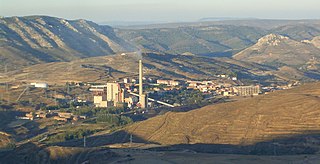The Vectis Formation is a geological formation on the Isle of Wight and Swanage, England whose strata were formed in the Barremian, approximately 125 million years ago. The environment of deposition was that of a freshwater coastal lagoon with occasional marine influence after the early Aptian marine transgression, transitioning from the floodplain environment of the underlying Wessex Formation. The primary lithology is of laminated grey mudstones. The Vectis Formation is composed of three geological members: the Shepherds Chine member, the Barnes High Sandstone member, and the Cowleaze Chine member. It is overlain by the fully marine Atherfield Clay Formation, part of the Lower Greensand Group. Dinosaur remains are among the fossils that have been recovered from the formation.

The Camarillas Formation is a geological formation in the Teruel Province of Aragón, Spain whose strata date back to the Early Cretaceous. The sandstones, mudstones and conglomerates of the formation, that due to syn-sedimentary faulting varies greatly in thickness from 300 to 800 metres, were deposited in fluvial, deltaic and lacustrine environments.

The Escucha Formation is a geological formation in La Rioja and Teruel provinces of northeastern Spain whose strata date back to the late Aptian to middle Albian stages of the Early Cretaceous. Dinosaur remains are among the fossils that have been recovered from the formation.

The Almond Formation is a geological formation of Late Cretaceous age in Wyoming. It was deposited in marsh, deltaic, lagoonal, estuarine, and shallow marine environments along the western shore of the Western Interior Seaway. It consists primarily of fine- to medium-grained sandstone, siltstone, shale, and coal. Fossils from the Almond Formation include remains of dinosaurs and plants.
The Viñita Formation is a geological formation in Coquimbo, Chile, whose strata date back to the Late Cretaceous. Dinosaur remains are among the fossils that have been recovered from the formation.
The Bajo Barreal Formation is a geological formation in the Golfo San Jorge Basin of Chubut and Santa Cruz, Argentina whose strata date back to the Middle Cenomanian to Late Turonian. The formation was first described by Teruggi & Rossetto in 1963. The sandstones, claystones, mudstones, conglomerates and tuff were deposited in a fluvial environment. The upper part of formation is laterally equivalent to the Yacimiento El Trébol and Meseta Espinosa Formation and the lower part to the Laguna Palacios, Cañadón Seco and Comodoro Rivadavia Formations. The Bajo Barreal Formation is a reservoir rock in the Golfo San Jorge Basin.
The Ankarafantsika Formation is a Late Cretaceous (Cenomanian) geologic formation of the Mahajanga Basin in the Boeny region of Madagascar, Africa. The fine-grained sandstones of the formation were deposited in a fluvial to lacustrine environment.

The Hidden Lake Formation is a Late Cretaceous geologic formation in Antarctica. The sandstones and siltstones of the formation were deposited in a deltaic environment.
The In Beceten Formation, also Beceten or Ibecten is a Coniacian to Santonian geologic formation in the Iullemmeden Basin of Niger. Dinosaur remains are among the fossils that have been recovered from the formation, although none have yet been referred to a specific genus. The lithology primarily consists of clays, fine limestones and sandy clays.
The Hornitos Formation is a Campanian geologic formation of the Algarrobal Basin in the Atacama Region of northern Chile. The formation comprises limestones, sandstones, conglomerates, marls and tuff. Dinosaur remains are among the fossils that have been recovered from the formation, including the sauropod Arackar licanantay.
The Puerto Yeruá Formation is a Late Cretaceous geologic formation in the Paraná Basin, pertaining to Entre Ríos Province, Argentina. Dinosaur remains are among the fossils that have been recovered from the formation, as well as egg fragments and fossilized wood.
The Akaiwa Formation is an Early Cretaceous (Hauterivian-Barremian) geologic formation in central Honshu, Japan. Indeterminate ornithischian fossils are known from the formation. Fossil ornithopod tracks have been reported from the formation. As well as the turtle Kappachelys
The Thomas Fork Formation is an Early Cretaceous (Albian) geologic formation in Wyoming. Fossil dinosaur eggs have been reported from the formation.
The Mercedes Formation is a Late Cretaceous geologic formation of the Norte Basin in Uruguay. Fossil dinosaur eggs have been reported from the formation. The formation that reaches a thickness of about 100 metres (330 ft), overlies the Guichón Formation and is overlain by the Asencio Formation.
Sphaerovum is an oogenus of dinosaur egg that has only been discovered in South America.

The Malargüe Group is a group of geologic formations of the Neuquén Basin of the Mendoza, Neuquén, Río Negro and La Pampa Provinces in northern Patagonia, Argentina. The formations of the Malargüe Group range in age between the middle Campanian to Deseadan, an Oligocene age of the SALMA classification, straddling the Cretaceous–Paleogene boundary, about 79 million to 30 million years in age. The group overlies the older Neuquén Group, separated by an unconformity dated to 79 Ma. The rocks of the Malargüe Group comprise both marine and continental deposits which are over 400 m (1312 ft) thick in total.
The Tacuarembó Formation is a Late Jurassic (Kimmeridgian) geologic formation of the eponymous department in northern Uruguay. The fluvial to lacustrine sandstones, siltstones and mudstones preserve ichnofossils, turtles, crocodylomorphs, fish and invertebrates.
The Aïn el Guettar Formation is a geological formation in Tunisia, whose strata date back to the Late Aptian to Early Albian stages of the Cretaceous period. The lithology consists of coarse sandstones with occasional conglomerates and mudstones. Dinosaur remains are among the fossils that have been recovered from the formation.
Udelartitan is an extinct genus of saltasauroid titanosaurian sauropod dinosaur from the Late Cretaceous Guichón Formation of Uruguay. The genus contains a single species, U. celeste, known from fragmentary remains of at least two individuals.





